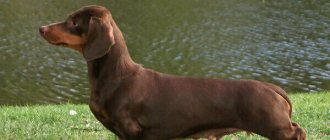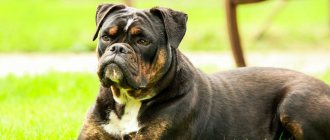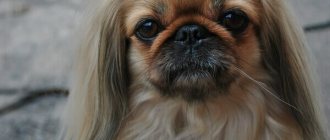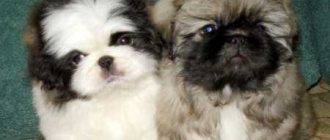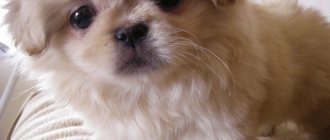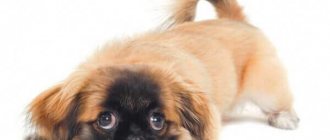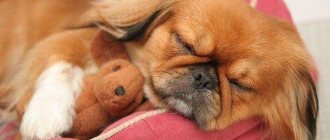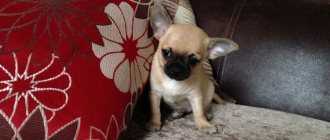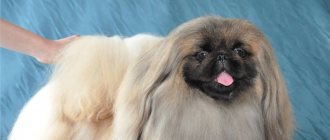Pekingese are one of the oldest dog breeds. Previously, they lived only in the palaces of the Chinese nobility. They were worshiped as divine dogs. Today, Pekingese have not lost their popularity; the dogs are among the most popular decorative breeds.
International kennel clubs do not divide Pekingese into subspecies. Mini Pekingese (sleeve, pocket) is not a separate breed. In a litter of show class puppies, miniature representatives are considered a waste. But such babies are valued no less than their standard counterparts. They are preferred by lovers of pocket dogs. But you need to be prepared that mini Pekingese will not be allowed to participate in international exhibitions and breeding.
Origin and history of the breed
It is still unknown exactly when the Pekingese appeared. The first mentions of them date back 2 thousand years ago. China is considered the birthplace of the breed. The first Pekingese differed from modern ones in having high limbs and a more graceful body.
Initially, these dogs were kept in the monasteries and palaces of the local nobility as companions. Ordinary residents of the Middle Kingdom could not afford to have Pekingese. It was believed that these animals protected the palaces of their owners from evil spirits. There was even a separate servant to care for the Pekingese. In case of errors in care, the servants could even be executed.
For a long time, Pekingese did not leave China. Only after 1860, when Anglo-French troops invaded the country, these dogs came to Europe as trophies. In 1894, the breed was first presented at an exhibition. At the same time, it received its official name. In China, after the fall of the empire, Pekingese were no longer bred. And only a few decades later they returned to their homeland from Europe again.
Care and nutrition
When grooming, you should pay all your attention to working with the animal’s fur. Maintaining shine, silkiness and health of the skin will require proper regular care.
Each treat should be completed with a brushing of the fur on the face, and each outdoor walk should be completed with a thorough cleaning of the paws.
Systematic combing of the coat is recommended to avoid tangles. It is necessary to wash the dog in warm water, using shampoos for long-haired dogs as a detergent.
After bathing, it is necessary to dry the coat thoroughly (preferably without a hair dryer) and comb it hard.
Only constant combing will be able to maintain the magnificent appearance of the coat, and in some cases even increase its attractiveness. Eyes require attention. It requires daily cleaning to remove all kinds of dirt. A soft scarf is the ideal “tool” here.
Rubbing the eyes with cotton swabs is not recommended by Pekingese care specialists and dog breeders. This is due to the increased risk of corneal irritation. A traditional problem for dwarf Pekingese is eyeball prolapse, so care needs to be monitored, otherwise the eyes will become unevenly bulging.
If even a slight discrepancy is detected, the most expedient solution is to contact a veterinarian without aggravating the situation.
Cleaning the ears is done with special products for animals that can dissolve the accumulation of earwax. A 3% hydrogen peroxide solution is used.
Dental care
Regarding the teeth of mini Pekingese, there is only one thing worth saying - they need care, and not periodically, but constantly and properly. After finishing eating, you should look into the animal’s mouth to examine the oral cavity for the presence of pieces of food between the incisors.
When the dog is at home most of the time, it is worth taking care in advance to trim his nails on a regular basis to avoid ingrown nails.
Care requires compliance with the entire procedure, which is essential, however, the eyes should still be given more attention and time. Only comprehensive eye care hygiene will protect your animal from illnesses. The process itself includes daily wipes with either a soft cloth or a damp swab.
In a situation where characteristic discharge (purulent) appears, it is imperative to resort to antibiotics. For those who do not have the information to understand what to buy at a pet pharmacy, it is best to contact a consultant.
Characteristics and standards
Officially, mini Pekingese do not exist. As a rule, the smallest puppies from the litter are sold under this name. To qualify as a mini, an adult dog must weigh no more than 3.18 kg. In all other respects, the sleeve Pekingese must meet the standard of the normal one.
Find out the instructions for using the probiotic for dogs Forti Flora with lactobacilli, vitamins and minerals.
Photos of trichophytosis in dogs, features and rules for treating the infectious disease can be seen in this article.
Breed standards:
| Frame | The body is short, but not square, tapering slightly towards the pelvis, forming a waist. The bones are strong and well developed. |
| Head | Wide, quite large in relation to the body. The skull is massive, flattened from the dorsal to the ventral surface and the frontal plane. The forehead is wide and flat. The bridge of the nose is recessed into the skull. The nose is turned up, at eye level. |
| Eyes | Large, oval, set wide apart. They are convex, covered by eyelids with a dark border. Eye color is dark. |
| Ears | Medium, hanging on cartilage, adjacent to the skull. The tips of the ears should not go beyond the line of the upper teeth. |
| Tail | Set high, curled into a half ring, slightly curved to the side. Covered with flowing long hair. |
| Limbs | Short, powerful. The front legs are slightly curved at the forearm area. The rear ones are a little thinner, but just as powerful. |
| Wool, color | Long, straight, has a short dense undercoat. It forms a frill in the neck and chest area. The hair on the head is shorter and coarser. The color can be varied. Red and fawn are more common. Less common are black and white Pekingese. |
Mini Pekingese: how it differs from the standard one
There is no mention of mini Pekingese in breed standard No. 207. According to the standard, the ideal weight is 5-5.4 kg. But representatives weighing up to 3 kg are also recognized as Pekingese. The lack of clear boundaries for height and weight was the impetus for some dog breeders to divide the breed into subspecies.
According to scientists, the reason why “dwarfs” appear in a litter of normal-sized puppies is a mutation in the IGF-1 gene. Mini Pekingese females weighing no more than 3.18 kg are not allowed for breeding. They may give birth to standard puppies, as a result of which the bitches may die. Miniature males are bred with standard females to produce miniature offspring.
Apart from the size, mini Pekingese are no different from standard ones. There are no differences in color, coat type, or anatomical structure. But miniature representatives are not allowed to participate in exhibitions; they are considered a defect of the breed.
Exterior Features of Mini Pekingese
The first thing you need to understand when getting acquainted with the dwarf Fu (as they were previously called in their homeland in China) is that this is just a variety of Pekingese, and not a separate breed. A puppy that never grows to standard size may be born in a litter of ordinary Pekingese.
Important! According to standards, the weight of an adult Pekingese is 5-5.5 kg. A dwarf (sleeve, pocket) representative of the breed usually weighs 2.5-3 kg.
It is possible to understand that a puppy belongs to the “mini” category only when it reaches the age of 8 months. In general, pocket Fu is no different from its standard counterparts except for size. The coat, colors, shape of the ears and body, and the structure of the muzzle are the same. The only thing that sleeve females are not allowed to do is participate in breeding. This ban does not apply to males.
Character and intelligence
Despite their miniature size, Mini Pekingese rightfully consider themselves royalty. They are majestic and noble, requiring a lot of attention. This is a brave and proud dog that feels at its best in any society.
Pekingese are very jealous. If there are small children or other animals in the house, the dog will always “dislike” them. The dwarf pet is very touchy and full of self-esteem. Therefore, you always need to be affectionate with him, show maximum attention and care. Pekingese do not tolerate neglect.
These dogs are very attached to their things. They will bravely defend the right to property. Therefore, they should always have their own toys, bowl, and bedding.
Advantages and disadvantages
Mini Pekingese are unique dogs that not everyone can keep. Before you get such a pet, you should study its strengths and weaknesses.
Advantages of the breed:
- toy appearance;
- devotion;
- cold resistance;
- devotion to the owner;
- good security qualities;
- unpretentiousness in feeding.
Minuses:
- high price;
- difficulty in training and toilet training;
- frequent shedding;
- breathing problems due to the structure of the muzzle;
- may snore;
- stubbornness;
- jealousy.
Care and conditions of detention
Pekingese require a lot of attention. It is very important to follow the basic rules of hygiene, arrange a comfortable place to live, and regularly care for the coat, ears, and eyes.
How to train to a litter box and to go out for a walk
Pekingese are quite difficult to toilet train. Therefore, training should be started immediately after the puppy arrives in the house. As a rule, disposable diapers are used for this. After each dog's bowel movement, the diaper needs to be changed. As soon as the puppy begins to behave restlessly, you need to put a diaper on him so that he can defecate. Over time, replace the diaper with a tray with low sides. The diaper can be placed inside.
If you are training your puppy to use the toilet outside, you need to regularly take him out after eating and after sleeping at the same time. At first, you can take with you a tray with the smell of animal urine. The puppy must learn that now the toilet will be outside.
Feeding puppies and adult dogs
After 3 months, puppies can be accustomed to food other than mother's milk. First, meals should be 5 times a day. Gradually, the Pekingese is transferred to 2 meals a day.
Water porridge (rice, buckwheat) is introduced into the diet of small dogs. You can add a little oil to them. Expand your diet with cottage cheese and fermented milk products. This is an essential source of calcium for a growing body.
From 6 months you can introduce meat and fish. It is better to give preference to beef, turkey, and chicken. It is important to have boiled vegetables and fruits in your daily diet. The condition of its coat and overall health depends on the diversity of the mini Pekingese's diet.
If you feed your dog ready-made food, it should be super premium. They should have more protein and a minimum of carbohydrates. The food should also contain vitamins and minerals that your pet needs.
The best ready-to-eat brands:
- Eukanuba;
- Orijen;
- Monge;
- Royal Canin;
- Akana;
- Brit;
- Arden Grange and others.
Place to sleep
Before a puppy appears in the house, he needs to prepare a place in advance. It should be located away from drafts and heating appliances. Due to their long, thick coat, Pekingese do not tolerate heat well. You can buy a special bedding, or make a dog bed with your own hands. Place it in a secluded corner where the animal can retire.
Hygiene
Wool requires the most attention. It is recommended to brush it daily with a soft brush or use a furminator to avoid the formation of tangles. You can bathe your dog with a special shampoo in warm water once a month or more often. After bathing, dry the coat well with a hairdryer and comb it thoroughly.
Your eyes also require daily care. This is one of the Pekingese's weak points. They need to be cleaned regularly from dirt using a soft handkerchief. It is better not to use cotton swabs so as not to irritate the cornea. If there is purulent discharge, the eyes are treated with products containing an antibiotic.
Ears are cleaned with special products that can dissolve wax. Typically a 3% hydrogen peroxide solution is used. It is recommended to brush your dog’s teeth at least once a week with a special brush and paste to prevent the deposition of tartar and hard plaque. Claws should be trimmed as they grow.
Walks
Most representatives of the Mini Pekingese are not big fans of long walks. But you need to walk your dog regularly. To do this, 15-20 minutes 3 times a day is enough. In summer, when it is very hot outside, it is better to walk only in the morning and late evening.
It is better to choose places for walks where there are no large dogs. Pekingese can be cocky, which can put them in danger. You only need to walk your mini Pekingese on a leash so that he cannot run after someone.
Vaccinations and treatment against worms
Like other breeds, the Mini Pekingese needs timely vaccinations according to age. Only a completely healthy dog can be vaccinated. 1-2 weeks before vaccination, it is necessary to remove worms from the dog using special deworming drugs, and treat against fleas, lice, ticks, lice and other parasites.
Approximate vaccination schedule:
Toys
Mini Pekingese should have their own toys. It is quite enough to have 2 toys - one can be soft, the other can be rubber. Also, for outdoor games, you can buy a ball with a diameter of about 15 cm. Developmental toys that will occupy the pet’s time while the owner is away will not be superfluous.
Haircuts
Some owners prefer to trim mini Pekingese dogs in the summer. This makes it easier for dogs to cope with the heat. For hygienic purposes, it is recommended to trim the hair on the paws around the pads.
Care and maintenance
The main problem will be grooming. Shedding, severe loss of undercoat, requires regular brushing. You need to bathe your dog once every six months, and the rest of the time, you can use dry shampoo. Particular attention should be paid to cleaning after a walk or feeding.
We must not forget about the eyes, which also need to be cleaned of dust and dirt. You will have to wipe them daily using a soft, lint-free cloth. Dogs are prone to various eye diseases (eye loss, conjunctivitis, keratitis). Even a simple walk in tall grass can result in injury. Abundant purulent discharge and lacrimation are a serious reason to contact a veterinarian.
The animal's teeth and claws require additional care. Moreover, you need to brush your teeth daily , using a piece of gauze wrapped around your finger, and trim your nails as they grow (once a month). The ears are cleaned once every 2 weeks using cotton swabs soaked in a solution of hydrogen peroxide.
Training and education
Pekingese are very difficult to train. It's all about the dog's stubborn and arrogant character. She considers herself the main one in the house and does only what she considers necessary. You need to train your pet from childhood, until he fully feels like a leader. In the future, all attempts to re-educate him will be in vain.
The Mini Pekingese is not designed to follow complex commands. But he can be trained to basic dog commands: “come to me,” “sit,” and “lie down.” During classes, be sure to encourage your pet and praise it. Physical punishment is absolutely contraindicated. The dog can be seriously and permanently offended. Classes should be systematic and short so that the dog does not have time to get bored.
Breed diseases
The structural features of the Mini Pekingese's muzzle cause problems with the eyes and respiratory system. The breed is often diagnosed with:
- cataract;
- eversion of eyelids;
- corneal ulcer;
- laryngitis;
- tracheitis;
- bronchitis.
Look at a selection of effective methods for treating dog ear vasculitis, and also learn about preventing the development of pathology.
The first signs, symptoms and methods of treating adenovirus infection in dogs are written on this page.
Follow the link and read about the rules for using Hepatovet suspension for small breed dogs.
Pekingese also have a weak cardiovascular system and often develop:
- heart attack;
- hemophilia;
- Congenital heart anomalies occur.
Due to the short legs and long body, the load on the spine increases. This leads to the development:
- herniated intervertebral discs;
- osteochondrosis;
- joint diseases.
Choosing a puppy
No breeder can guarantee that there will be a mini Pekingese in the litter. The appearance of such instances is an exception to the rule. Therefore, such a puppy can cost crazy amounts of money. The price of a mini can exceed several thousand dollars.
It is better to buy a Pocket Pekingese when he is already 8 months old. It is at this age that it becomes clear that this is really a “dwarf”. By this time, the puppy should already have received all vaccinations and be treated for worms. Be sure to ask the breeder for documents for the dog.
Sleeve Pekingese
A Pekingese is considered to be a sleeveless breed if its weight after 8 months does not exceed 3 kg. This is the smallest pet of all. During the breeding of this breed, this species was the most popular and in demand.
A distinctive feature of the Sleeve Pekingese is the oriental expression of the muzzle. They got their name because emperors and empresses wore them in the long sleeves of their clothes. A warm lump helped them warm up in the cold rooms of the palaces. Simply put, they were used for heating. Therefore, relatively small representatives of the already miniature breed were used for these purposes.
It is possible to determine which subspecies a particular puppy belongs to only after eight months. Until the age of eight months it is impossible to judge its identity. Also, younger puppies are not called dwarf or pocket, so conscientious breeders do not sell Pekingese until they reach adulthood.
Representatives of this breed usually live 12-15 years, but there is evidence of sleeve Pekingese that lived up to 20 years.
Pekingese: origin and character
Pros of the Pekingese breed
Related Posts
Owner reviews
You can find many reviews about Pekingese, since this breed is very popular. Mini Pekingese are not so common due to their scarcity and high cost. But they have no special differences from standard Pekingese, except for size.
Most owners note the dog's strong attachment to its owner. At the same time, this is a very zealous creature that requires attention only to itself. The negative side for many was regular grooming and frequent heavy shedding. Therefore, it is not recommended for very clean people to own a Pekingese.
Briefly about the breed
Both the Royal and Standard Pekingese are considered to have originated in China. Lying on the soft pillows of the emperors, the dogs behaved like royalty. Pekingese have been awarded the following names: the dog of the Heavenly Emperor, as well as the titled person of kings.
There is even a legend about the love of a monkey and a lion, supposedly the Pekingese is the fruit of their “romantic relationship.” Naturally, any normal person thinks this is funny, but if you look closely, the Pekingese really has a facial expression like a monkey, and the spiritual qualities of a proud and independent lion, a brave heart and courage.
There are many legends about this sacred animal from Beijing; it is also known that dogs with such a physique and a flattened wide muzzle existed 2 thousand years ago. Pekingese were also used as watchmen and warned of military operations and any rustle, sensing danger. They also accompanied emperors to audiences, barking at courtiers to bow to the emperor.
How did the mini Pekingese appear? It was difficult for the court ladies to care for a large representative of the breed, so the royal nobility decided to start reproducing a new subspecies - a very tiny one.
In fact, small specimens were found in litters of standard large representatives of the breed. Even during the reign of Manchu, a tiny mini Pekingese appeared, no more than 3 kg in size, although the standard ones reached 5 kg. These mini dogs became an adornment for the ladies of the court, also called “muff dogs” or sleeve dogs. Women wore them everywhere, and kept warm thanks to the fluffy fur of the dogs, placing them in the sleeve of a kimono.
These babies are not always in excellent health, and in general, mini Pekingese are a defective breed and are currently not allowed for exhibitions. Retailers try to sell their beauties at a higher price, but you must remember that these are scammers.
A standard for these babies is currently being developed in the UK; it is known that the weight should be no more than 3 kg, and in Canada and the USA it is considered to be no more than 2.7 kg.
A careful selection of such “defective” Pekingese dogs is carried out, since their skeletal system is not always developed correctly; if there are deviations, the puppies are not allowed for sale at all.
Real dwarf Pekingese are absolutely healthy and, according to the description, completely match the usual standard ones, the only difference is height and weight. And they live up to 14-15 years, completely sharing all the sorrows and happy moments with the owner.
